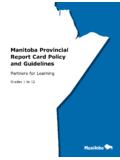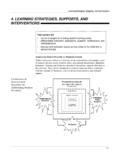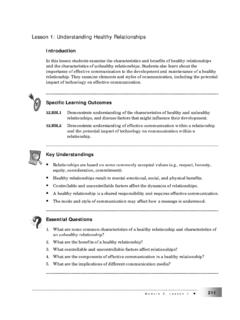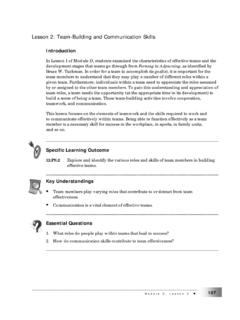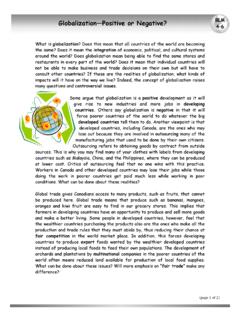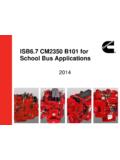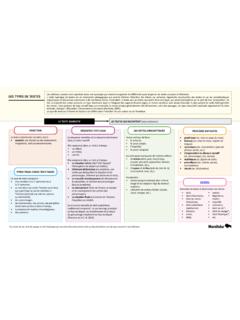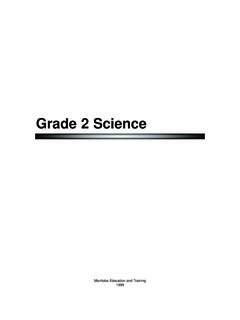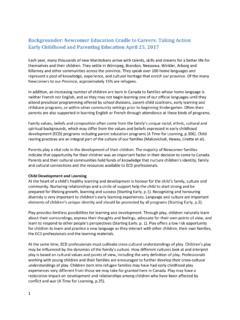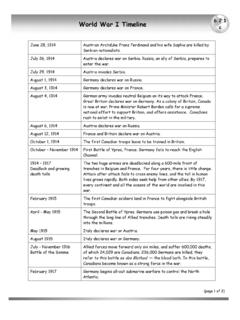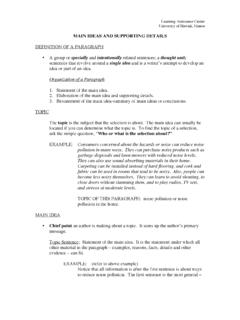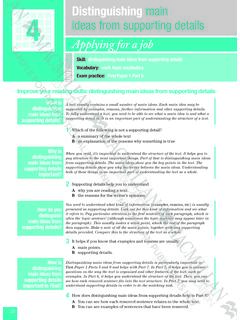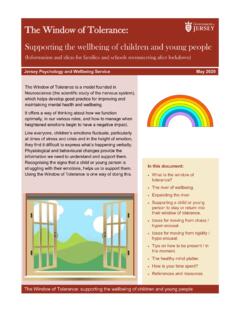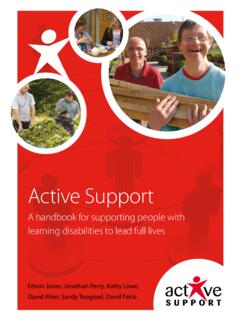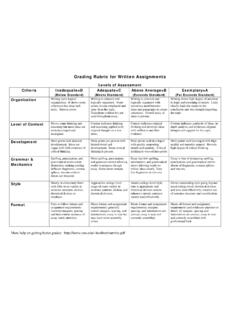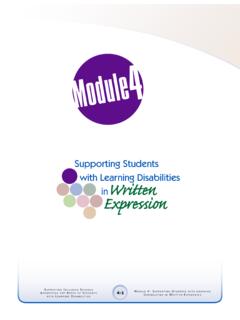Transcription of Supporting Students with Reading Disabilities
1 3-1SU P P O R T I N G IN C L U S I V E SC H O O L SAD D R E S S I N G T H E NE E D S O F ST U D E N T S W I T H LE A R N I N G DI SA B I L I T I E SMO D U L E 3 : SU P P O R T I N G ST U D E N T S W I T H RE A D I N G DI SA B I L I T I E S3 ModuleSupporting Students with Reading Disabilities3-2SU P P O R T I N G IN C L U S I V E SC H O O L SAD D R E S S I N G T H E NE E D S O F ST U D E N T S W I T H LE A R N I N G DI SA B I L I T I E SMO D U L E 3 : SU P P O R T I N G ST U D E N T S W I T H RE A D I N G DI SA B I L I T I E SThis module provides information about the characteristics of Students with Reading Disabilities as well as programming approaches to support these Students . Key ideas in this Module Reading Disabilities account for the majority of all learning Disabilities . Effective instructional practice for Students with a learning disability is a combination of direct instruction, strategy instruction, and time for rehearsal and practice.
2 Effective Reading requires strength in building meaning using cues and conventions of language, Reading fluency, and Reading comprehension. Good teaching practices work for all Students but are essential for Students with a Reading disability. Two teaching practices that may assist Students with a Reading disability across curricular areas are gradual release of responsibility and Before, During and After (BDA). Listening, speaking, Reading , writing, viewing, and representing are the six areas of language arts that are essential from early childhood through our adult lives. Even though Reading and writing are presented in separated modules, it is important to remember they are closely linked. What Is a Reading Disability? A Reading disability is a learning disability that involves an impairment of Reading accuracy, speed, or comprehension and is significant enough to interfere with academic achievement and/or activities of daily life. Students with Reading Disabilities have average or above average intelligence but experience a disparity between their cognitive abilities and their ability to read.
3 Their difficulties can be unexpected in relation to their age or the amount and quality of instruction they have received. In the Diagnostic and Statistical Manual of Mental Disorders, Fifth Edition (DSM-5), the diagnostic term Specific Learning Disorder with Impairment in Reading is used as outlined in Module 1 for individuals who experience difficulty with word Reading accuracy, Reading rate or fluency, or Reading comprehension. (p. 67, DSM-5) Dyslexia is an alternate term used to describe specific Reading difficulties that result from visual/perceptual difficulties with print that effect spelling, decoding, and word recognition. The term Reading Disabilities , used in this module, encompasses a range of difficulties that include word recognition, fluency, and Reading comprehension. A Reading disability is not a cognitive disability. Students with Reading Disabilities have average or above average cognitive ability. Their difficulty is learning to read.
4 3-3SU P P O R T I N G IN C L U S I V E SC H O O L SAD D R E S S I N G T H E NE E D S O F ST U D E N T S W I T H LE A R N I N G DI SA B I L I T I E SMO D U L E 3 : SU P P O R T I N G ST U D E N T S W I T H RE A D I N G DI SA B I L I T I E S Up to 80% of children with learning Disabilities have difficulty learning to read. (World Summit Learning Disabilities , December 2008) Almost 40% of Canadian youth do not have adequate literacy levels. (Literacy Matters: A Call to Action) Characteristics of Students with Reading Disabilities A student with a Reading disability may experience difficulty in any combination of the following areas: Difficulty mastering letter sounds and vocabulary: Students with Reading Disabilities tend to have difficulty learning letter sounds, combinations of sounds, and vocabulary words. Difficulty monitoring performance: Students with Reading Disabilities are not usually adept at monitoring their own understanding of Reading material.
5 Failure to apply strategies learned in a variety of contexts: The strategies that support successful Reading vary in subject/content areas and also vary from one assignment to the next. Reading a textbook, for example, requires different strategies and skills than Reading a story. Students with Reading Disabilities do not adjust their strategies accordingly. Difficulty in generalization: Students with Reading Disabilities have difficulty transferring concepts that have been learned in one context to another context. Memory problems: Students with Reading Disabilities often demonstrate challenges with memory and have difficulty retaining their understanding from Reading material. Over-dependency: Students with Reading Disabilities tend to be over-dependent on others for direction in their learning. This impacts Reading assignments, which tend to be individual assignments. Approaching a task: Students with Reading Disabilities may have a history of limited success or repeated failure, and they may not approach a challenging learning task with a positive attitude.
6 Instructional Strategies to Support Students with a Reading Disability Good first teaching is essential for Students with Reading Disabilities . What works for Students with Reading Disabilities can work for other Students too. There is no one solution, each student learns differently and the severity of learning needs can vary from mild to moderate to severe. Students with Reading Disabilities require extensive time and practise to learn the skills involved with Reading . Efforts must be intense and prolonged with teaching and Reading 3-4SU P P O R T I N G IN C L U S I V E SC H O O L SAD D R E S S I N G T H E NE E D S O F ST U D E N T S W I T H LE A R N I N G DI SA B I L I T I E SMO D U L E 3 : SU P P O R T I N G ST U D E N T S W I T H RE A D I N G DI SA B I L I T I E Ssessions that take place over a significant amount of time. It is crucial that Students have access to a variety of Reading materials that are meaningful, engaging, and at their level.
7 When educators and/or the student support team select strategies and interventions for Students with Reading Disabilities , they should consider two aspects of learning: the subject-area content that must be mastered and the cognitive processes required to learn. Direct instruction, or explicit teaching, is recommended to teach content. Strategy instruction is the way in which cognitive processes are strengthened. Rehearsal and practice is the way in which new information becomes learning. Research has shown that the most effective intervention for learning Disabilities involves direct instruction strategy instruction rehearsal and practice (See Module 2) Assistive Technology Even with skilled classroom instruction, some Students with a Reading disability will continue to struggle. When the school team has determined through the assessment process that the student is not progressing, assistive technology may be required. Assistive technology is a term used to describe any piece of equipment or software used to increase a student s efficiency with learning, maintaining function, or improving capacity.
8 These tools allow a student with a Reading disability to demonstrate their intelligence and knowledge by allowing them access to materials, strategies, content, and processes to meet curricular outcomes. Early Years Emerging evidence suggests that Reading Disabilities can be detected in very young children through the observation of an inability to manipulate individual phonemes. (Yopp, 1992) The inability to distinguish sounds and reproduce phonemes can lead to difficulty in primary Reading skills. This leads to difficulties in Kindergarten and Grade 1 when children begin to learn letter and sound associations. Children may begin to fall behind in their recognition of written letters and simple words and, by the end of Grade 1, they may display the characteristics of a child with a Reading disability. By the time they enter school, children may have difficulties, including the following: delayed language skills (expressive and receptive); poor phonological skills; difficulty with phonics; 3-5SU P P O R T I N G IN C L U S I V E SC H O O L SAD D R E S S I N G T H E NE E D S O F ST U D E N T S W I T H LE A R N I N G DI SA B I L I T I E SMO D U L E 3 : SU P P O R T I N G ST U D E N T S W I T H RE A D I N G DI SA B I L I T I E S poor retention of rote information.
9 Throughout the elementary years, Students may have difficulty with the following: naming and recognizing letters; retaining a store of sight words; understanding relationships between sounds and letters; tracking on the page as they read. Teaching Materials/Methods to Support Reading in Early Years For young, struggling readers in the classroom, there are many materials, resources, teaching methods, and technologies that can be used to support learning. Some examples include the following: A word-rich classroom environment to create word awareness; Word-walls to display a collection of words in the classroom; Word games, words-of-the day, or mystery words to introduce new words; High-interest, low-vocabulary books; Books with supports such as large print and ample space between words; Reading material that is at the instructional or independent grade levels of the Students with difficulty Reading , which may be well below their current grade level; Reading material that is engaging for both genders; On-line resources such as You-Tube or other Web resources with audio; Reading material that includes many sight words to increase automaticity; Reading material that can be decoded; Alternative ways of telling stories ( , felt board stories, puppets to dramatize well-known stories, audio books).
10 Alternative ways of presenting new information ( , using sensory modalities such as tactile and kinaesthetic, as well as traditional modalities); Choral Reading and reader s theatre to add fun to oral Reading ; Buddy systems for Reading ; A supportive environment where Students are comfortable and prepared for oral Reading or not required to read aloud; Ongoing, constructive feedback for Students as they read. 3-6SU P P O R T I N G IN C L U S I V E SC H O O L SAD D R E S S I N G T H E NE E D S O F ST U D E N T S W I T H LE A R N I N G DI SA B I L I T I E SMO D U L E 3 : SU P P O R T I N G ST U D E N T S W I T H RE A D I N G DI SA B I L I T I E SMiddle Years and Senior Years Some Students show signs of Reading Disabilities in pre-school or early years; however, for other Students , Reading Disabilities will not become evident until they are older and they are required to read to learn. Often, these children are able to mask or hide their Reading difficulties due to the fact that they have average intelligence and strengths in their communication, creative thinking skills, and problem-solving abilities.
